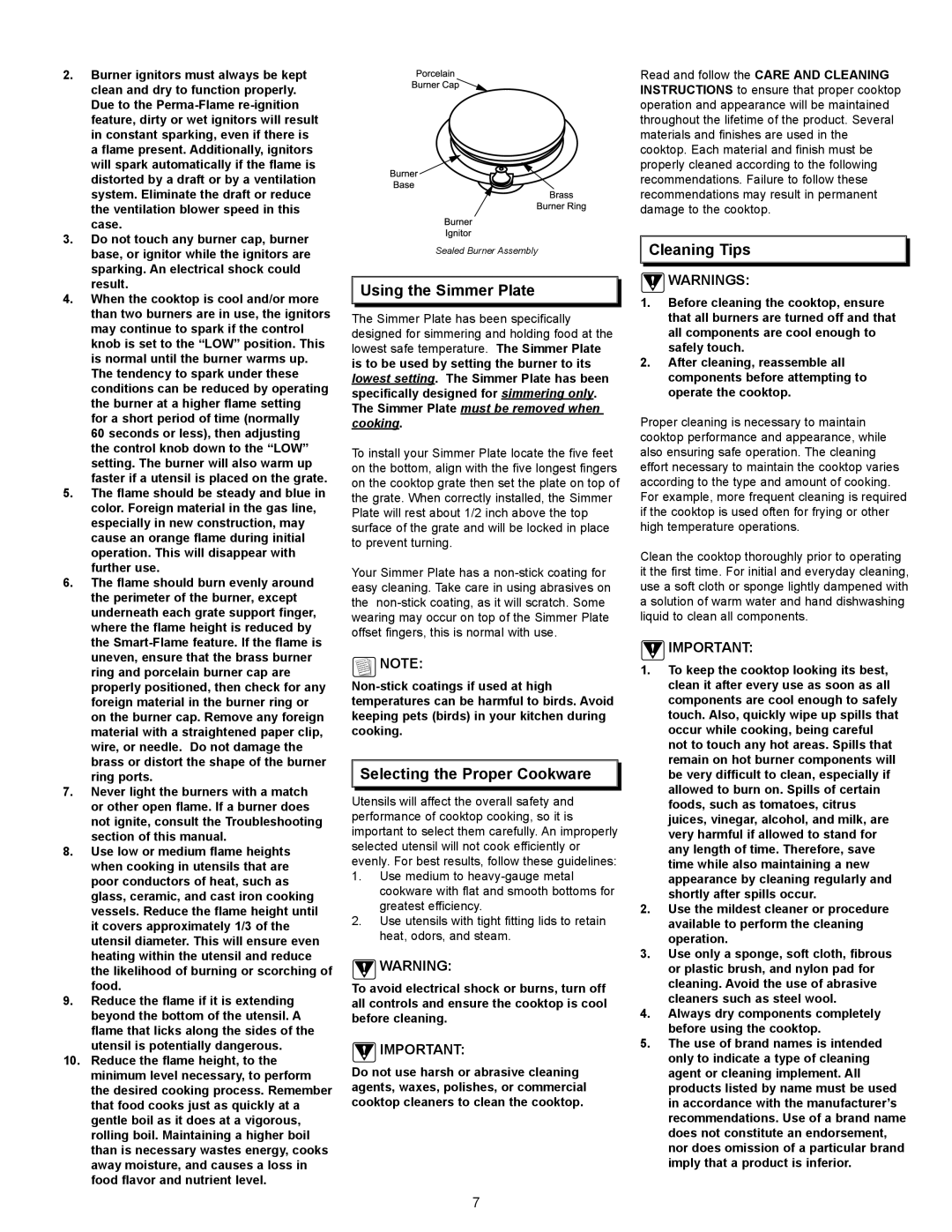
2.Burner ignitors must always be kept clean and dry to function properly. Due to the
3.Do not touch any burner cap, burner base, or ignitor while the ignitors are sparking. An electrical shock could result.
4.When the cooktop is cool and/or more than two burners are in use, the ignitors may continue to spark if the control knob is set to the “LOW” position. This is normal until the burner warms up. The tendency to spark under these conditions can be reduced by operating the burner at a higher flame setting for a short period of time (normally
60 seconds or less), then adjusting the control knob down to the “LOW” setting. The burner will also warm up faster if a utensil is placed on the grate.
5.The flame should be steady and blue in color. Foreign material in the gas line, especially in new construction, may cause an orange flame during initial operation. This will disappear with further use.
6.The flame should burn evenly around the perimeter of the burner, except underneath each grate support finger, where the flame height is reduced by the
7.Never light the burners with a match or other open flame. If a burner does not ignite, consult the Troubleshooting section of this manual.
8.Use low or medium flame heights when cooking in utensils that are poor conductors of heat, such as glass, ceramic, and cast iron cooking vessels. Reduce the flame height until it covers approximately 1/3 of the utensil diameter. This will ensure even heating within the utensil and reduce the likelihood of burning or scorching of food.
9.Reduce the flame if it is extending beyond the bottom of the utensil. A flame that licks along the sides of the utensil is potentially dangerous.
10.Reduce the flame height, to the minimum level necessary, to perform the desired cooking process. Remember that food cooks just as quickly at a gentle boil as it does at a vigorous, rolling boil. Maintaining a higher boil than is necessary wastes energy, cooks away moisture, and causes a loss in food flavor and nutrient level.
Sealed Burner Assembly

 Using the Simmer Plate
Using the Simmer Plate
The Simmer Plate has been specifically designed for simmering and holding food at the lowest safe temperature. The Simmer Plate is to be used by setting the burner to its lowest setting. The Simmer Plate has been specifically designed for simmering only. The Simmer Plate must be removed when cooking.
To install your Simmer Plate locate the five feet on the bottom, align with the five longest fingers on the cooktop grate then set the plate on top of the grate. When correctly installed, the Simmer Plate will rest about 1/2 inch above the top surface of the grate and will be locked in place to prevent turning.
Your Simmer Plate has a
![]() NOTE:
NOTE:

 Selecting the Proper Cookware
Selecting the Proper Cookware
Utensils will affect the overall safety and performance of cooktop cooking, so it is important to select them carefully. An improperly selected utensil will not cook efficiently or evenly. For best results, follow these guidelines:
1.Use medium to
2.Use utensils with tight fitting lids to retain heat, odors, and steam.
![]() WARNING:
WARNING:
To avoid electrical shock or burns, turn off all controls and ensure the cooktop is cool before cleaning.
![]() IMPORTANT:
IMPORTANT:
Do not use harsh or abrasive cleaning agents, waxes, polishes, or commercial cooktop cleaners to clean the cooktop.
Read and follow the CARE AND CLEANING INSTRUCTIONS to ensure that proper cooktop operation and appearance will be maintained throughout the lifetime of the product. Several materials and finishes are used in the cooktop. Each material and finish must be properly cleaned according to the following recommendations. Failure to follow these recommendations may result in permanent damage to the cooktop.

 Cleaning Tips
Cleaning Tips
![]() WARNINGS:
WARNINGS:
1.Before cleaning the cooktop, ensure that all burners are turned off and that all components are cool enough to safely touch.
2.After cleaning, reassemble all components before attempting to operate the cooktop.
Proper cleaning is necessary to maintain cooktop performance and appearance, while also ensuring safe operation. The cleaning effort necessary to maintain the cooktop varies according to the type and amount of cooking. For example, more frequent cleaning is required if the cooktop is used often for frying or other high temperature operations.
Clean the cooktop thoroughly prior to operating it the first time. For initial and everyday cleaning, use a soft cloth or sponge lightly dampened with a solution of warm water and hand dishwashing liquid to clean all components.
![]() IMPORTANT:
IMPORTANT:
1.To keep the cooktop looking its best, clean it after every use as soon as all components are cool enough to safely touch. Also, quickly wipe up spills that occur while cooking, being careful not to touch any hot areas. Spills that remain on hot burner components will be very difficult to clean, especially if allowed to burn on. Spills of certain foods, such as tomatoes, citrus juices, vinegar, alcohol, and milk, are very harmful if allowed to stand for any length of time. Therefore, save time while also maintaining a new appearance by cleaning regularly and shortly after spills occur.
2.Use the mildest cleaner or procedure available to perform the cleaning operation.
3.Use only a sponge, soft cloth, fibrous or plastic brush, and nylon pad for cleaning. Avoid the use of abrasive cleaners such as steel wool.
4.Always dry components completely before using the cooktop.
5.The use of brand names is intended only to indicate a type of cleaning agent or cleaning implement. All products listed by name must be used in accordance with the manufacturer’s recommendations. Use of a brand name does not constitute an endorsement, nor does omission of a particular brand imply that a product is inferior.
7
